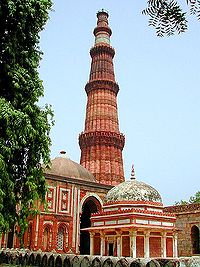History Of Delhi City
History of Delhi enumerates a saga of various dynasties like the Mughals, Khilji and Tuglaks who once ruled this city. The first ever evidence of Delhi can be traced back to the times of Mahabharata in 1400 BC when it was known by the name of Indraprastha. However, it is said that Anagpal Tomar first laid the foundation stone of the seven ancient cities of Delhi much before the 13th century.
Prithviraj Chauhan played a major role in shaping the history of Delhi. In fact he was the last Hindu Emperor who ruled the city of Delhi. After this great Hindu ruler, Qutub-ud-din-Aibak of Turkish origin propounded the Slave Dynasty in Delhi that lasted from 1211 to 1227.
The Khilji Dynasty started in Delhi just after the end of the Slave Empire. From 1296 to 1316 Khilji Dynasty ruled Delhi and also established the Siri city within its premises. The Tughluqs took the rein of Delhi after the Khilji Dynasty and established the third city called as Tughluqabad.
It is believed that the Mughal Empire had immense influence on the all-round socio-economic development of the city. As a whole, the unique History of Delhi helped in shaping up the political, social, architectural, cultural and economic scenario of India in the ancient times.
Delhi hasn’t always been India’s capital, but it has played a pivotal part in Indian history as it has always been a gateway city, built on the plains initially near a fording point on the Yamuna River and on the route between western and central Asia and Southeast Asia. It’s also believed to be the site of the fabled city of Indraprastha, which featured in the Mahabharata over 3000 years ago, but historical evidence suggests that the area has been settled for around 2500 years.
At least eight known cities have been founded aroun d modern Delhi, the last of which was the British Raj’s New Delhi. The first four cities of Delhi were to the south, around the area where the Qutb Minar now stands. The fifth Delhi, Firozabad, was at Firoz Shah Kotla in present-day New Delhi, while Emperor Sher Shah created the sixth at Purana Qila, also in New Delhi. The Mughal emperor, Shah Jahan, constructed the seventh Delhi in the 17th century, thus shifting the Mughal capital from Agra to Delhi; his Shahjahanabad roughly corresponds to Old Delhi today and is largely preserved. The Chauhans seized control in the 12th century and made Delhi the most significant Hindu centre in northern India. But when Qutb-ud-din occupied the city in 1193, he ushered in more than six centuries of Islamic rule. In 1803, the British captured Delhi and promptly installed a British administrator. Delhi wasn’t the capital of India at the time, but it was a critical commercial centre.
d modern Delhi, the last of which was the British Raj’s New Delhi. The first four cities of Delhi were to the south, around the area where the Qutb Minar now stands. The fifth Delhi, Firozabad, was at Firoz Shah Kotla in present-day New Delhi, while Emperor Sher Shah created the sixth at Purana Qila, also in New Delhi. The Mughal emperor, Shah Jahan, constructed the seventh Delhi in the 17th century, thus shifting the Mughal capital from Agra to Delhi; his Shahjahanabad roughly corresponds to Old Delhi today and is largely preserved. The Chauhans seized control in the 12th century and made Delhi the most significant Hindu centre in northern India. But when Qutb-ud-din occupied the city in 1193, he ushered in more than six centuries of Islamic rule. In 1803, the British captured Delhi and promptly installed a British administrator. Delhi wasn’t the capital of India at the time, but it was a critical commercial centre.
In 1911, the British announced the shifting of their capital from Kolkata (Calcutta; Bengal was ardently championing independence) and proceeded to build New Delhi as though the sun would never set on the Raj. Construction wasn’t completed, and the city officially inaugurated, until 1931. However, only 16 years after the grand inauguration, the British were booted out of India and Delhi became the capital of an independent India.
Since Independence, Delhi has prospered as the capital of modern India, with its population spiralling upwards due to rapid economic expansion and increased job opportunities. The downside of this boom – apart from growing pressure on the city’s groaning infrastructure – is chronic overcrowding, traffic congestion, ballooning child labour, housing shortages and pollution.
